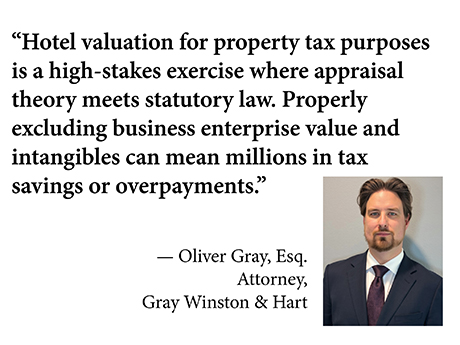By Oliver Gray, Esq., of Gray Winston & Hart
Valuing hotels for property taxation is one of the most complex and contested areas in real estate appraisal. And unfortunately for hotel owners, improper assessment is common and costly.
Unlike office buildings or warehouses, hotels are not just physical assets — they are operating businesses. This distinction requires appraisers to carefully separate the taxable real estate, which is land and improvements, from the nontaxable business enterprise and intangible assets. Failing to do so risks unlawfully taxing the business itself, a critical concern for Texas hotel owners and property tax professionals.

Texas law mandates that assessors appraise property at its fee-simple market value, excluding exempt intangibles and business value. For hotels, this means appraisers cannot simply capitalize the income of the operating business. Rather, they must make adjustments to remove components tied to franchise affiliation, management expertise, brand recognition and other intangibles.
The challenge is clear: How can assessors, taxpayers and their appraisers correctly isolate the real property value from the going concern? What follows are several common approaches and their inherent weaknesses, which can skew an assessor’s conclusions or provide bases to challenge inflated assessments.
Management Fee Method
One widely used — but flawed — method is the management fee method, also named the Rushmore approach after Stephen Rushmore, founder of hospitality consulting firm HVS. Developed in the 1980s and originally designed for financing valuations, this method deducts management and franchise fees, reserves for replacement and minor residual intangibles from a hotel’s net operating income, then capitalizes the remainder as the real property’s rental Texas value.
While seemingly straightforward, this approach has a critical failing. As explained by appraiser David Lennhoff, a leading authority on separating intangible business value, franchise and management arrangements, these intangible items are not just expenses but also investments designed to generate returns. By deducting only the costs, the Rushmore method leaves intangible returns embedded in the income stream, resulting in inflated taxable values that include business enterprise value.
In practice, this often leads to over-assessment, effectively taxing the hotel’s business operations rather than just its real estate.
Business Enterprise Approach
Lennhoff created an alternative called the business enterprise approach (BEA) and asserts that hotel income includes a quantifiable return on intangibles including brand, goodwill and a trained workforce. Appraisers and assessors must deduct these intangible-derived returns to arrive at true real property value, he contends.
The most prominent debate in hotel valuation today pits the Rushmore approach against Lennhoff’s BEA. The latter’s supporters argue Rushmore leaves too much business value in the taxable base, while critics claim BEA valuations remove too much.
Rushmore proponents argue their method sufficiently strips business value, and courts in New Jersey and other states have accepted it. However, courts in California and elsewhere have rejected Rushmore for assessment purposes.
One way to frame the difference: Rushmore values the hotel as a business, while BEA values the real estate used to operate a hotel.
O’Connor Offers Middle Ground
Texas practitioners have recently advanced the O’Connor Approach, developed by Mary O’Connor, principal-in-charge of the forensic and valuation practice at professional services company Sikich. This method quantifies the incremental revenue impact of a hotel’s brand by analyzing changes in average daily rate, occupancy and revenue per available room when a flag is added or removed. The model then nets out associated costs like franchise and loyalty program fees.
The resulting net gain is treated as nontaxable business value and removed from the income stream before capitalization. This approach avoids Rushmore’s under-adjustment and BEA’s alleged “double dipping.” Courts outside of Texas, including Arkansas, have accepted this framework, which sometimes cuts assessed values in half.
Still, the O’Connor approach faces scrutiny. Some appraisers question whether brand impact can be cleanly isolated, given overlapping factors like location, management quality and capital improvements. Others worry that aggressive application could shift too much value into the intangible category, risking under-taxation of real property.
Equal and Uniform, a Texas Twist
Another strategy for Texas hotel owners is pursuing an equal-and-uniform (E&U) appeal under Section 42.26 of the state’s tax code. Rather than challenge market value directly, this appeal tests whether the property is assessed equitably compared to comparable hotels.
A common E&U tool is the room revenue multiplier. By dividing appraised or sale values of comparable hotels by room revenue, consultants can establish benchmark ratios. If a subject hotel’s assessed value per room or per-revenue dollar materially exceeds the median of its peers, the owner may demonstrate nonuniform treatment and secure a reduction.
While powerful, E&U appeals have limitations. They do not fully adjust for brand affiliation or loyalty programs, which influence revenue. As such, E&U works best as a complement to fee-simple valuation arguments, not as a replacement.
The preceding review of valuation methods offers clear implications for Texas hotel owners. Foremost, those taxpayers should review assessments with a skeptical eye, ideally with a local tax adviser, and contest inflated values. If an appraisal district relies on the management fee method, it may be unlawfully taxing intangibles. Likewise, challenge Rushmore-only valuations. While Rushmore has judicial support, it may not fully exclude nontaxable components as required by Texas law.
For the taxpayer’s appraisal, consider the O’Connor approach. Its blend of brand-driven revenue analysis and expense offsets align well with Texas’ fee-simple standard. An E&U appeal as a parallel strategy can improve the taxpayer’s chances for success. Revenue room multiplier comparisons can secure reductions based on inequitable treatment, even if income-based arguments stall.
Hotel valuation for property tax purposes is a high-stakes exercise where appraisal theory meets statutory law. Properly excluding business enterprise value and intangibles can mean millions in tax savings or overpayments.
Texas hotel owners and advisors should pursue both market value challenges and equal-and-uniform appeals as complementary strategies. Together, these approaches create a stronger defense than either can alone.
As valuation debates evolve, hotel owners must remain vigilant, understand the flaws of shortcut methods and advocate for assessments that reflect both economic reality and legal boundaries. Property taxes should be levied on real property, and not on the brand equity, goodwill, and operating acumen that make a hotel succeed.
Oliver Gray is an attorney at Gray Winston & Hart, the Texas member of American Property Tax Counsel, the national affiliation of property tax attorneys. Reach him at oliver@graywinston.com.


